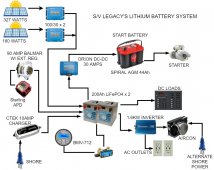
I finally went for it. Batteries and components are on order. Is there anything I should do differently? Here are some details:
The batteries will be made from 280Ah LiFePO4 cells from AliExpress. I'm making two separate batteries, each with its own Daly 150 amp BMS. I did this for redundancy as we are actively cruising in remote places (except during Covid times!) as well as to increase current handling capability.
Solar, alternator and shore charger will all charge a small, 18AH AGM starting battery. Two Victron Orion 30 amp, DC to DC (12-12) converters will charge the LFE batteries. This will limit the output of my Balmar 90 amp alternator to 60 amps. The alternator has a Balmar MC-614 regulator. After the alternator is hot, I seldom get much more than 60 amps anyway so I'm not too concerned about a slight loss of charging amps. Also, it will help reduce wear on the single belt.
Our existing shore charger is small and seldom used, even at the dock. Solar takes care of our electrical needs almost all of the time.
By setting my system up this way, I'm thinking that I'll only have one source charging the LFE bank that I need to worry about. I'm thinking I'll set the Orions up in power-supply mode at a fixed voltage, just slightly lower than a 100% SOC voltage.
This is a simplified drawing and fuses will be added as necessary. So what did I get wrong? What should I do differently? Thanks in advance!
By the way, the drawing is thanks to @Gockleyd for the link to diagrams.net (formerly draw.io). This is an amazing tool. What wasn't obvious at first is that you can just drop images into the scratchpad area and use then as symbols. It's so easy!





